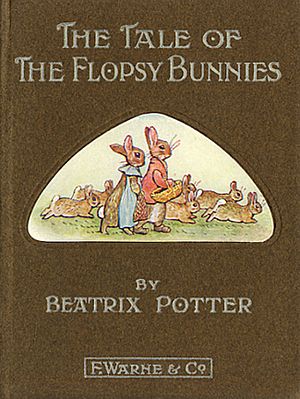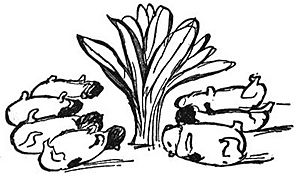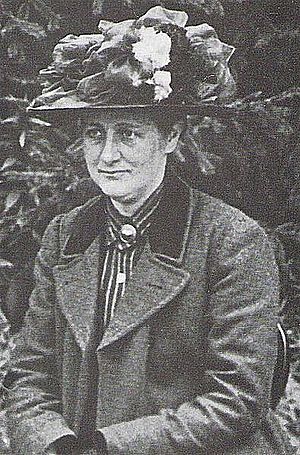The Tale of the Flopsy Bunnies facts for kids

First edition cover
|
|
| Author | Beatrix Potter |
|---|---|
| Illustrator | Beatrix Potter |
| Country | England,United Kingdom |
| Language | English |
| Genre | Children's literature |
| Publisher | Frederick Warne & Co. |
|
Publication date
|
July 1909 |
| Media type | Print (hardcover) |
| Preceded by | The Tale of Samuel Whiskers or The Roly-Poly Pudding |
| Followed by | The Tale of Ginger and Pickles |
The Tale of The Flopsy Bunnies is a children's book by Beatrix Potter. She wrote and drew all the pictures for it. The book was first published in July 1909 by Frederick Warne & Co.
Beatrix Potter had already written two popular books about rabbits. She wasn't sure she wanted to write another one. But she knew that children really loved her rabbit stories and drawings. So, she used characters and ideas from her earlier books, The Tale of Peter Rabbit (1902) and The Tale of Benjamin Bunny (1904). This helped her create The Flopsy Bunnies. The beautiful garden in the book was inspired by a real garden in Wales. This garden belonged to her aunt and uncle.
In The Flopsy Bunnies, Benjamin Bunny and his cousin Flopsy are grown up. They have six young rabbits, who are called The Flopsy Bunnies. The story tells how these young bunnies go looking for food. They find a pile of old vegetables and eat too much. They fall asleep and are caught by Mr. McGregor. He puts them in a sack. But a clever woodmouse named Thomasina Tittlemouse helps them. She frees the bunnies. Benjamin and Flopsy then fill the sack with rotten vegetables instead. Mr. McGregor proudly takes the sack home to his wife. But she gets very angry when she finds out what's really inside!
Contents
About the Author: Beatrix Potter
Beatrix Potter was born in Kensington, London on July 28, 1866. Her parents were wealthy, and she was taught at home. From a young age, Beatrix loved to draw. She sketched animals, insects, flowers, and plants. In the early 1890s, she sold some of her drawings for greeting cards. This was her first success as an artist.
Her most famous book, The Tale of Peter Rabbit, was first printed in 1901. A bigger publisher, Frederick Warne & Co., released it in 1902. It became very popular. Beatrix then wrote many more similar stories for them. In 1904, she published The Tale of Benjamin Bunny, which was a follow-up to Peter Rabbit.
In 1905, Beatrix bought a farm called Hill Top, Cumbria in the Lake District. She used the money she earned from her books and a small gift from her aunt. This farm became her second home and a quiet place where she could draw and write. Beatrix Potter built her own successful career and home.
How the Story Came to Be
In 1908, Beatrix Potter told her publisher, Harold Warne, about new book ideas. One idea was a sequel to The Tale of Benjamin Bunny. It would be about Benjamin's children, the Flopsy Bunnies. Even though she sometimes felt tired of writing about rabbits, she knew children loved them most. She wrote to a young fan that she should write another rabbit book.
The Tale of the Flopsy Bunnies was chosen to be published in 1909. Beatrix finished the book in March 1909, and it came out in July of the same year.
Beatrix also created special letters from the Flopsy Bunnies. The letters from the youngest bunnies were just tiny scribbles and kisses. Thomasina Tittlemouse, the clever mouse in the story, even got her own book in 1910, called The Tale of Mrs. Tittlemouse.
Story Summary: What Happens in the Book
In The Flopsy Bunnies, Benjamin Bunny and Peter Rabbit are grown up. Benjamin has married his cousin Flopsy, who is one of Peter's sisters. Peter, Mopsy, and Cotton-Tail still live with their mother, Mrs. Josephine Rabbit. Benjamin and Flopsy have six young rabbits, known as The Flopsy Bunnies.
Benjamin and Flopsy are "very improvident and cheerful." This means they are happy but don't always plan well for food. Sometimes, they get cabbages from Peter Rabbit, who is now a florist. But when Peter doesn't have extra cabbages, the Flopsy Bunnies go to Mr. McGregor's rubbish heap. They look for old vegetables there.
One day, they find and eat a lot of lettuce that has gone to seed. Eating too much lettuce makes them very sleepy. They fall fast asleep in the rubbish heap. Benjamin even puts a sack over his head to nap. Mr. McGregor finds them by accident while dumping grass clippings. He puts all six sleeping bunnies into a sack and ties it shut. He then sets the sack aside to do other things.
Benjamin and Flopsy can't help their children. But a clever woodmouse named Thomasina Tittlemouse comes to the rescue! She chews a hole in the sack, and the bunnies escape. The rabbit family then fills the sack with rotten vegetables. They put in two old turnips and three rotten vegetable marrows. After that, they fix the hole the mouse made. They hide under a bush to watch what Mr. McGregor will do.
Mr. McGregor doesn't notice the change. He still thinks he has the six baby rabbits. He carries the sack home, counting, "One, two, three, four, five, six leetle fat rabbits!" His wife, Mrs. McGregor, wants the rabbit skins for her old cloak. But when she reaches into the sack, she finds the rotten vegetables she threw out earlier! She gets very, very angry. She accuses her husband of playing a trick on her. Mr. McGregor also gets mad. He throws a rotten vegetable marrow out the window. It hits the youngest Flopsy Bunny, who was listening from the window sill. The hit breaks the bunny's arm. Their parents decide it's time to go home. The McGregors are left arguing.
At Christmas, the rabbits send the heroic little wood mouse a gift. It's a lot of rabbit-wool. She uses it to make herself a warm cloak, a hood, a muff, and mittens.
Illustrations and Art Style

In February 1909, Beatrix Potter worked hard on the drawings for The Flopsy Bunnies. She was at her farm, Hill Top, and the bad weather kept her inside. The garden in The Flopsy Bunnies was inspired by a real garden in Wales. This garden was at a place called Gwaeynynog, the home of her aunt and uncle. Beatrix had sketched this garden many times over the years.
She once described the garden in 1895: "The garden is very large, two-thirds surrounded by a red brick wall with many apricots, and an inner circle of old grey apple trees on espaliers. It is very productive but not tidy, the prettiest kind of garden, where bright old-fashioned flowers grow amongst the currant bushes."
Beatrix Potter found it hard to draw human faces. So, in The Flopsy Bunnies, she mostly shows Mr. McGregor's hands and feet. When she does show him fully, he is often far away or seen from behind. This way, she didn't have to draw his face.
However, Beatrix was very good at drawing rabbits. She showed their feelings by how their ears or tails were positioned. For example, Flopsy wears only an apron, so her tail is visible. When she is worried about her babies, her tail shows her fear as she crosses the lawn.
Some people think Beatrix was a bit tired of drawing rabbits by this time. In The Flopsy Bunnies, there are fewer close-ups of the rabbits. When they are shown, they are often seen from a middle distance. This allows the garden background to be included. The rabbits also have less facial expression. This might be because Beatrix, as a farm owner, started to see rabbits more as pests than as individual characters.
Book's Tone and Language
Beatrix Potter was very careful about how her books began and ended. In The Flopsy Bunnies, the story starts with a slightly more formal word: "It is said the effect of eating too much lettuce is 'soporific'." 'Soporific' means something that makes you sleepy. Beatrix knew this was a big word for kids. So, she immediately explains it and makes it fun: "I have never felt sleepy after eating lettuces; but then I am not a rabbit." This makes the story feel like someone is telling it directly to you.
She also uses the word "improvident" to describe Benjamin and Flopsy. This means they don't always plan ahead. But the pictures show them as cheerful, and the story explains that even if they don't always have food, there's always a way to find it, like at Mr. McGregor's rubbish heap.
For the first time, Mr. McGregor speaks in the book. He counts the bunnies with an accent: "six leetle fat rabbits." He also argues with his wife. This helps readers understand his character better. It also shows how Beatrix used different ways of speaking to make her characters unique.
Some experts feel that Beatrix Potter might have been less emotionally involved in writing The Flopsy Bunnies. They think she was more interested in drawing the garden than the rabbit characters. She had once said that the rabbit characters were "wearisome" (tiring). This might be why the story is shorter and focuses less on the rabbits' feelings.
Merchandise and Spin-offs
Beatrix Potter believed her stories would become classics for children. She was one of the first authors to sell products based on her characters. She had a Peter Rabbit doll, a board game, and even Peter Rabbit wallpaper in the early 1900s. She called these extra products "side-shows."
After Beatrix Potter passed away in 1943, other companies were allowed to make merchandise based on her characters. For example, Beswick Pottery made porcelain figures of characters from the book, like Flopsy and Mrs. Tittlemouse. Other companies made music boxes and Christmas ornaments. While Peter Rabbit and Mr. McGregor were made into plush toys, the Flopsy Bunnies characters were not made into plush toys by a major company until later.
Different Editions and Languages
All 23 of Beatrix Potter's small books are still printed today. You can find them as audiobooks or e-books. They are also available in large collections or as individual books. Old first editions can be found by special book sellers. Even though Penguin Books bought Frederick Warne & Co. in 1983, the books still have the Frederick Warne name on them. In 1985, the pictures in the books were updated using new photos of Beatrix Potter's original drawings.
Beatrix Potter's books have been translated into almost 30 languages. These include Greek and Russian. The Tale of Peter Rabbit was the first to be translated into another language in 1912. It has even been published in braille and in hieroglyphic script!
The Tale of The Flopsy Bunnies has been published in many languages too. It came out in French in 1931, in Afrikaans in 1935, and in Dutch in 1946. It was also translated into German in 1947 and Japanese in 1971. These books have become a special part of childhood for many children around the world.
Adaptations
In 1995, the story of The Flopsy Bunnies was made into an animated episode. It was part of the TV series The World of Peter Rabbit and Friends. This episode also included the story of The Tale of Mrs. Tittlemouse.



